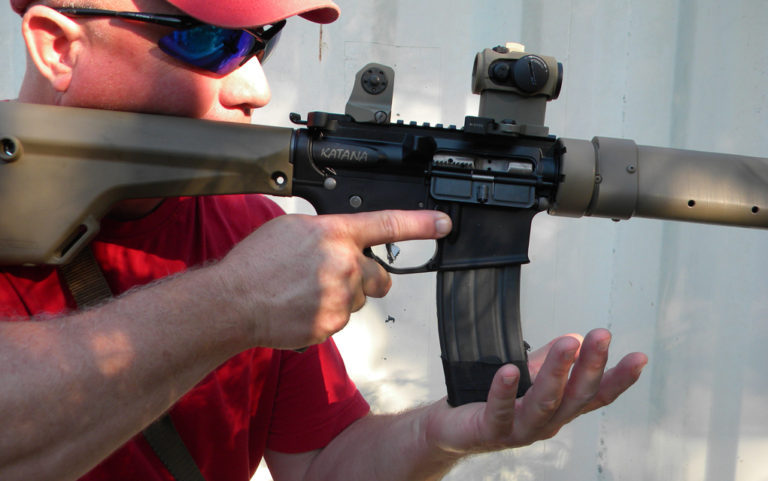
Understanding how to properly handle and fix common AR-15 malfunctions is a crucial part of operating this tactical rifle, particularly in defensive scenarios.
There are five types of AR-15 malfunctions that can occur. Two are common, a couple will crop up every once in a while, and the last, or Type V, you rarely see. Keep in mind this doesn’t count for jams or breakage.
A malfunction is something that you can apply a corrective set of actions and get the AR firing again, at least for one more shot. (If the AR is having a mechanical problem, such as a broken extractor spring, you’ll have another malfunction to clear after firing the next round.) A jam or breakage is something that takes time and tools to correct.
Some malfunctions are caused by bad ammo. Make it a habit when loading to check the rounds.
Malfunctions are often caused by the shooter, for example not ensuring the mag is seated and locked into place, which means no round in the chamber. We’ll discuss the malfunctions and what causes them, but for clearing them think about it along these lines: When the AR doesn’t fire, you’re going to load it. If this doesn’t work you’re going to unload and then load. A problem that can’t be solved by these actions is going to take time and/or tools to correct.
Basically we’re using a non-diagnostic approach to clearing malfunctions. This is why knowing how to load and unload is important. As with all other skills, consistency provides safety and predictable results from your actions. Practice and repetition is necessary to actually learn these skills, so they can be performed at a subconscious level.
Sometimes, especially with newer shooters or even experienced shooters under stress, people will forget to flip the safety off when they come up on target. Making this a habit is important, but whenever you press the trigger and it won’t be pressed make sure the safety is off. This is done using the same technique as always, a physical confirmation as opposed to stopping, flipping the carbine over and looking to see if the safety is on or off.
Step one for all these manipulations is to take your finger off the trigger and get it clear of the trigger guard. You don’t want to manipulate the AR, or any weapon, with the finger on the trigger or inside the trigger guard. Verbalizing this action, “finger off the trigger,” will help you remember to do this.
 Type I Malfunction
Type I Malfunction
You press the trigger and get “click” instead of “bang.” The Type I malfunction may be due to no round in the chamber; this is why we make sure to tug on the magazine to ensure it’s seated and check the chamber during the loading process to be sure there’s a round chambered. Or, the Type I malfunction can be due to a bad round, for example a faulty primer that doesn’t ignite the powder charge. Ultimately it doesn’t matter, we’re going to treat it the same by loading the AR.
First, finger off the trigger! The muzzle stays on target, just like when reloading, and the eyes maintain visual contact with the target. Next, tap and tug on the magazine to make sure it’s locked in place.
Normally you’ll use the support hand to tap and tug on the magazine, maintaining your grip with the strong hand. The alternative is to take the strong hand off the grip, using it to manipulate the AR while the support hand holds the handguard. Sometimes you may be tempted to skip the process of tapping and tugging on the magazine, but trust me, I’ve seen more Type I malfunctions caused by the shooter not seating the mag than all other malfunctions combined.
After ensuring the mag is seated, cycle the charging handle to load, just like you always do. Tapping and tugging on the mag ensures it’s seated, which may be the source of the problem. Cycling the charging handle loads the chamber. If the malfunction is due to a bad round this sequence will eject the faulty round and load a fresh one. The way the charging handle “feels” when you cycle it will tell you if this action was successful or not. You cycle the charging handle and it comes all the way to the rear and then slams forward. This action feels and sounds right. You’re ready to fire. If the charging handle doesn’t feel right when you attempt to cycle it then it’s time to go to the next step, which is described below.
 Type II Malfunction
Type II Malfunction
The Type II malfunction is a failure to eject an empty piece of brass. It’s commonly called a “stovepipe” or “smokestack,” which are terms used when this occurs with a pistol and the brass is sticking up like a stovepipe. With the AR they are sticking out to the side, partway in and out of the ejection port.
Although this is a different type malfunction from the Type I, your response is going to be the same. Again, finger off the trigger! Next, tap and tug on the magazine to make sure it’s seated and then cycle the charging handle to load. This action clears the Type I and II malfunctions. Again, you’re loading the AR; it’s just that the mag is already in the receiver.
There may be some times when the case sticking out of the ejection port is wedged or jammed in there, especially after cycling the bolt. When this occurs, you’ll need to lock the bolt to the rear to take pressure off the round. Then work the round clear by pulling it from the outside of the receiver. Again, once it’s clear make sure to cycle the bolt to ensure the chamber is clear, and then you’re ready to load.
 Type III Malfunction
Type III Malfunction
The third type of malfunction is what people normally call a “double feed.” There can be a few different causes for this malfunction. You could have a faulty magazine that allows an extra round to slip out of the magazine and you end up with two rounds trying to occupy one chamber. The extractor or ejector and/or springs could be failing, which means the AR doesn’t eject the empty case and the bolt is trying to feed a fresh round into the chamber. Sometimes it just happens, and there is no apparent reason and it doesn’t occur again.
This is also where the second part of the clearing procedure will come into play. You attempt to load the AR – finger off the trigger, tap and tug on the magazine and cycle the charging handle – but you can tell by the way the charging handle feels that this action did not work, the bolt did not go into battery, so you have to unload the AR and then load.
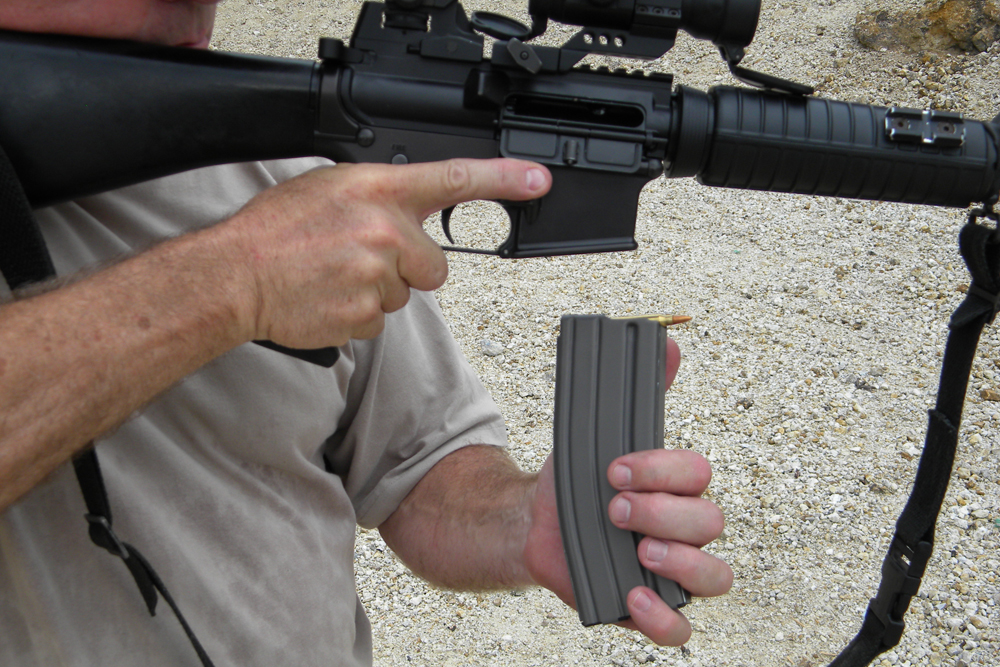 The type problem you have will dictate what steps are required to complete the unloading process. With a Type III malfunction, or “double feed,” the mag will not drop free as it normally does. The bolt is attempting to feed a round out of the magazine, but it doesn’t have anywhere to go. Part of the back portion of the round, the case, will still be in the mag, which prevents the mag from falling free when you press the mag release.
The type problem you have will dictate what steps are required to complete the unloading process. With a Type III malfunction, or “double feed,” the mag will not drop free as it normally does. The bolt is attempting to feed a round out of the magazine, but it doesn’t have anywhere to go. Part of the back portion of the round, the case, will still be in the mag, which prevents the mag from falling free when you press the mag release.
Pull or strip the mag out of the receiver. Continue the unloading process as you normally do, holding the mag in your support hand and cycling the bolt three times, just like always. If cycling the charging handle clears out the trash, and you can tell this by the way it feels, then you’re ready to load the AR.
 You cycle the bolt three times to clear out the trash but the charging handle is telling you there are still obstructions lodged in the upper receiver. To gain access to this and clear out the stoppage you have to lock the bolt to the rear, taking the pressure off the obstructions.
You cycle the bolt three times to clear out the trash but the charging handle is telling you there are still obstructions lodged in the upper receiver. To gain access to this and clear out the stoppage you have to lock the bolt to the rear, taking the pressure off the obstructions.
The support hand, still holding the mag, grasps the front of the receiver to support the rifle. For right-handed shooters this positions the left thumb to depress the bottom portion of the bolt release. Left-handed shooters are using the first finger of the right hand to engage the bolt catch. The primary hand comes off the AR’s grip, and you pull the charging handle all the way to the rear and lock the bolt back.
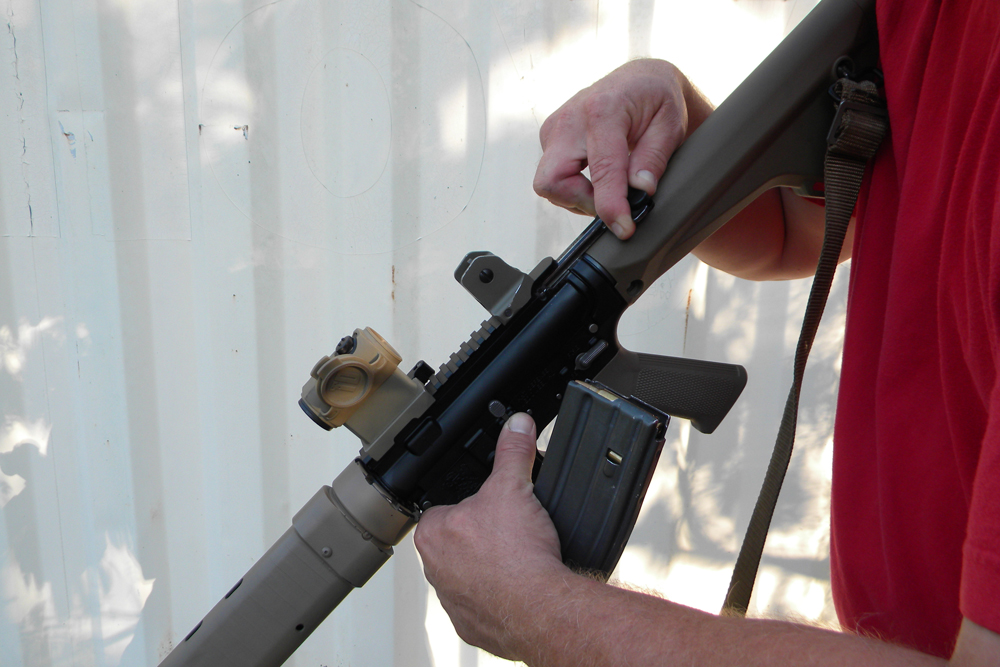 Reacquire your grip to support the rifle and stick your support-hand fingers up inside the mag well, pushing, wiggling and shoving until you feel or see something drop free. Remember, this hand is still holding the magazine. Also be sure to keep the muzzle on target and the mag well vertical. The largest opening in the AR is the mag well, so keeping the receiver vertical allows the trash to drop out the mag well easier, using gravity to assist.
Reacquire your grip to support the rifle and stick your support-hand fingers up inside the mag well, pushing, wiggling and shoving until you feel or see something drop free. Remember, this hand is still holding the magazine. Also be sure to keep the muzzle on target and the mag well vertical. The largest opening in the AR is the mag well, so keeping the receiver vertical allows the trash to drop out the mag well easier, using gravity to assist.
Once you feel or see something drop out of the mag well, remember the AR isn’t unloaded until you cycle the charging handle. There could still be a round or empty case in the chamber, and if you just immediately start to load the carbine all you’ll do is create another malfunction.
 After cycling the charging handle to ensure the chamber is clear you’re ready to load the rifle, inserting and seating the mag and cycling the bolt manually to chamber a round. Remember, this is a functional manipulation, so you’re not going to perform a press or chamber check, you’re just going to have faith the AR is doing what it’s supposed to. You’ll be able to tell this by the way everything feels when you load.
After cycling the charging handle to ensure the chamber is clear you’re ready to load the rifle, inserting and seating the mag and cycling the bolt manually to chamber a round. Remember, this is a functional manipulation, so you’re not going to perform a press or chamber check, you’re just going to have faith the AR is doing what it’s supposed to. You’ll be able to tell this by the way everything feels when you load.
This is why we unload the AR – an administrative action – the same way every time by removing the magazine and cycling the bolt three times. These same actions are used to clear the Type III malfunction, the only difference is that the muzzle is on target, you’ll have to strip the mag free from the receiver, and you’re not going to perform a press or chamber check after loading. In a situation where you have to clear a malfunction but don’t have to fire again, which would tell you immediately if the AR is working or not, you might want to check the chamber, when you have the opportunity.
 Type IV Malfunction
Type IV Malfunction
The Type IV malfunction is a case stuck in the chamber. The cause of this could be a couple of different things. The chamber of the AR could be too tight, not honed out to the proper size. A round could be out of shape or size, causing it to stick in the chamber. The extractor or extractor spring might be failing, which means it loses it’s grip on the case as the bolt moves rearward to extract, eject and feed another round.
The rifle will tell you when a Type IV malfunction occurs. Normally the charging handle will not come back at all because the extractor is locked onto the rim of the cartridge case stuck in the chamber. The AR doesn’t fire. You start, as always, by making sure the mag is locked in and then cycling the charging handle. Except in this case, the charging handle will not come back. You need to unload.
The support hand removes the mag from the receiver, and then goes to the handguard to hold the carbine. To cycle the charging handle you have to get some extra momentum and force, which is achieved by slamming the rear of the stock against a hard surface. This could be the ground or any other object that is solid enough to provide the resistance needed.
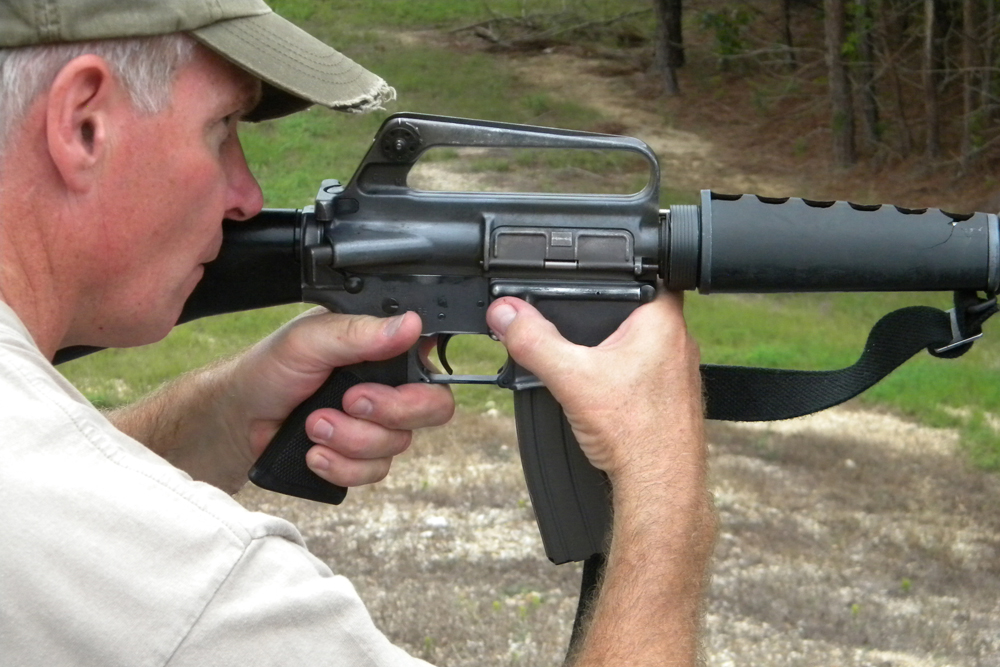 For ARs with adjustable stocks there are a couple of extra steps involved. Before slamming the stock down, or back against some other object, you need to collapse the stock, moving it all the way forward. Failure to do this can cause the stock to collapse permanently, breaking parts; break or bend the extension or buffer tube, which prevents the AR from shooting; or crack/break the upper receiver where the buffer tube is threaded into it. After clearing the case from the chamber, extend the stock back out to your normal working length. With fixed stocks you don’t have to worry about these extra steps.
For ARs with adjustable stocks there are a couple of extra steps involved. Before slamming the stock down, or back against some other object, you need to collapse the stock, moving it all the way forward. Failure to do this can cause the stock to collapse permanently, breaking parts; break or bend the extension or buffer tube, which prevents the AR from shooting; or crack/break the upper receiver where the buffer tube is threaded into it. After clearing the case from the chamber, extend the stock back out to your normal working length. With fixed stocks you don’t have to worry about these extra steps.
The support hand is holding the handguard and the primary hand goes to the charging handle. Position your “snake fangs,” the first two fingers of the hand, on each side of the charging handle. This helps ensure you’ll pull it straight to the rear as opposed to one side or the other.
Slam or bang the back of the stock while at the same time pulling the charging handle back. If you’re in a kneeling position, using the ground to slam the stock against, make sure to control the AR with the support hand, keeping the muzzle pointing in a safe direction.
This action will generate enough force to pull the case out of the chamber, or it will rip the rim off the case, in which case now you have a jam which requires time and tools to correct. (When this occurs it normally requires the use of a broken case extractor to remove the case from the chamber.) Come back up to standing, get the stock back into the shoulder, cycle the charging handle to ensure the chamber is clear and load.
 Type V Malfunction
Type V Malfunction
Occasionally you’ll see a bolt over-ride, a Type V malfunction, which is a case or live round on top of the bolt group and wedged into the receiver. The charging handle will normally come back part way, without any spring tension on it, but will come to a sudden stop before it reaches its full extension. Remove the magazine, if you haven’t already.
The support hand goes up the magwell so the first finger can press and hold the bolt to the rear. The primary hand goes to the charging handle. Pull the charging handle back while at the same time pressing the bolt to the rear. Once the bolt is back hold it there with the finger on the support hand and work the charging handle back and forth. The charging handle will dislodge the round or brass so that it can drop out of the lower receiver through the magwell. Cycle the bolt three times to make sure the chamber is clear and load.
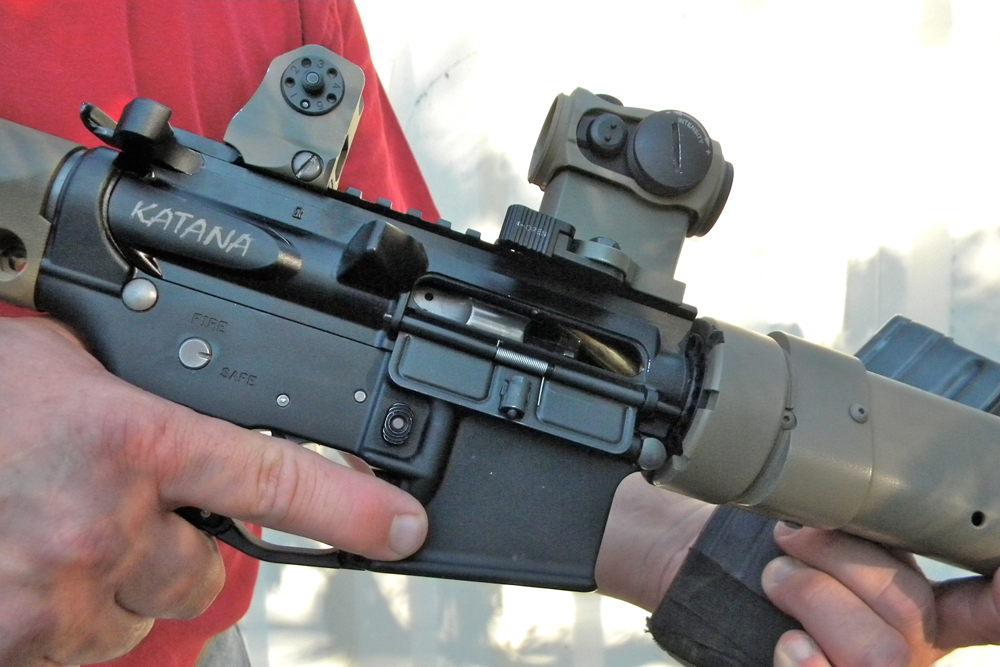 Safely and efficiently operating the AR is the result of consistency. For every action performed there is a correct and proper technique. Deviating from proper technique opens the door for trouble.
Safely and efficiently operating the AR is the result of consistency. For every action performed there is a correct and proper technique. Deviating from proper technique opens the door for trouble.
Consistency also creates efficiency. Ultimately your goal is to be able to perform all the manipulations required at a subconscious level. The conscious mind says, “reload.” The subconscious mind takes over and performs the reload. The same is true for malfunctions. This level of skill can only achieved through repetition, starting step by step and performing the same action over and over until you can perform it without needing to consciously think about the required actions.
Learning how to manipulate the AR isn’t complicated, but that doesn’t mean it’s easy. The degree to which you need to practice these actions depends on your application. For target shooting, the ability to perform lighting fast reloads might not be necessary.
The skills to reload or clear a malfunction efficiently are mandatory for armed professionals or anyone who may use the AR for self-defense. The best way to practice, getting in the repetitions necessary to learn these skills, is dry practice using dummy rounds to set up the different malfunctions. Whatever task you intend to use the AR for, you’ll get more pleasure and successful results from knowing how to manipulate it properly.
This article is an excerpt from AR-15 Skills & Drills.

Next Step: Get your FREE Printable Target Pack
Enhance your shooting precision with our 62 MOA Targets, perfect for rifles and handguns. Crafted in collaboration with Storm Tactical for accuracy and versatility.
Subscribe to the Gun Digest email newsletter and get your downloadable target pack sent straight to your inbox. Stay updated with the latest firearms info in the industry.


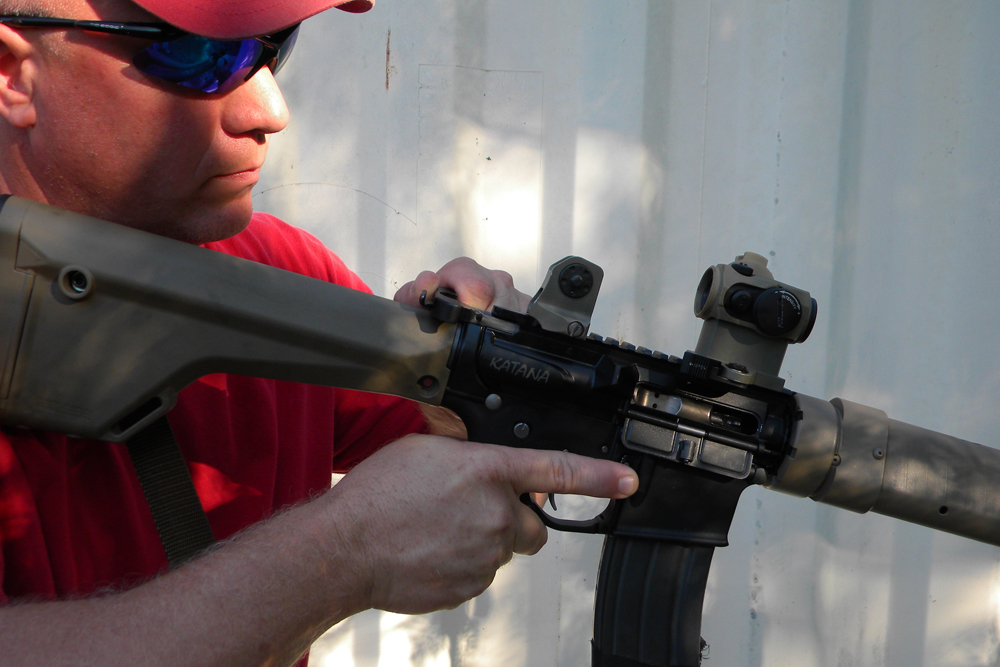 Type I Malfunction
Type I Malfunction Type II Malfunction
Type II Malfunction Type III Malfunction
Type III Malfunction Type IV Malfunction
Type IV Malfunction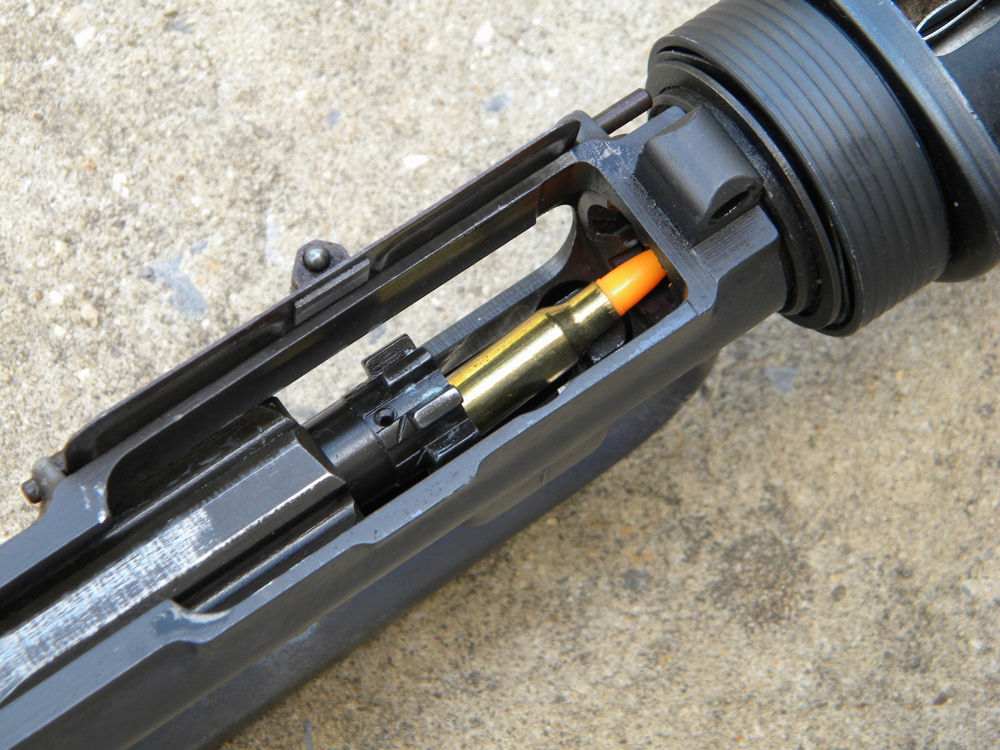 Type V Malfunction
Type V Malfunction![Best Concealed Carry Guns In 2025 [Field Tested] Wilson Combat EDC X9S 1](https://gundigest.com/wp-content/uploads/Wilson-Combat-EDC-X9S-1-324x160.jpg)


![Best 9mm Carbine: Affordable PCCs [Tested] Ruger Carbine Shooting](https://gundigest.com/wp-content/uploads/Ruger-Carbine-Shooting-100x70.jpg)

